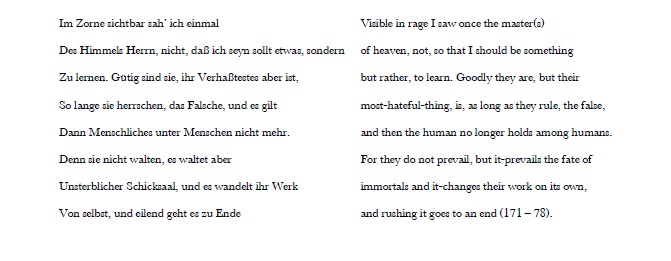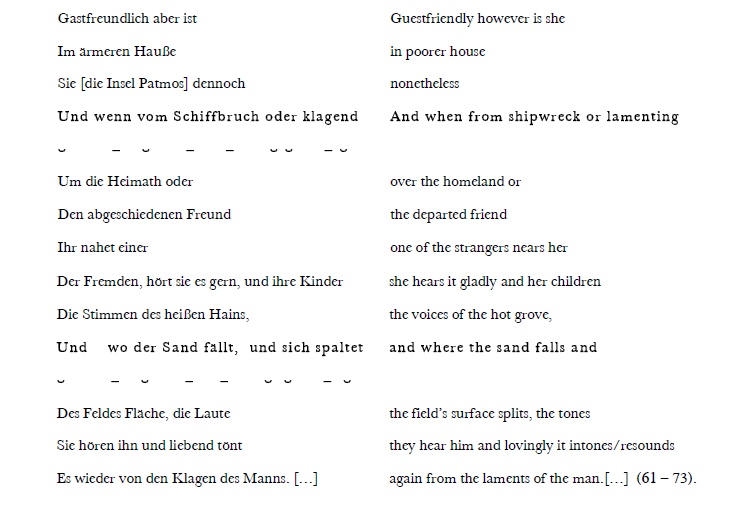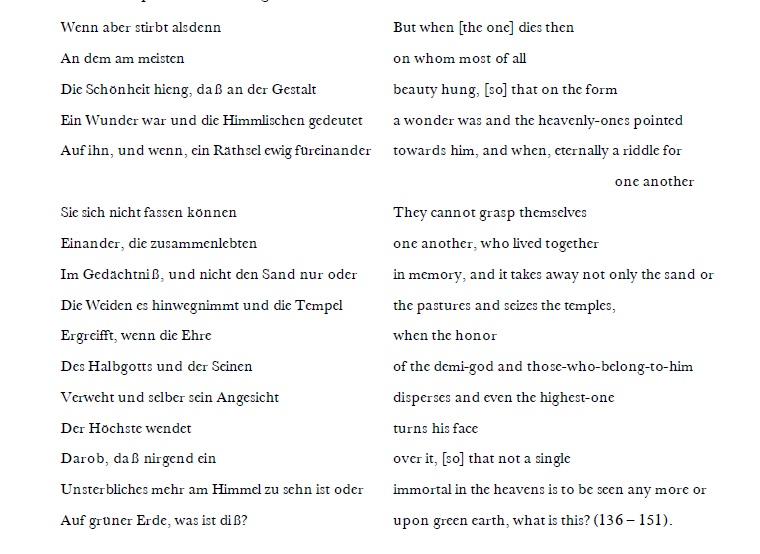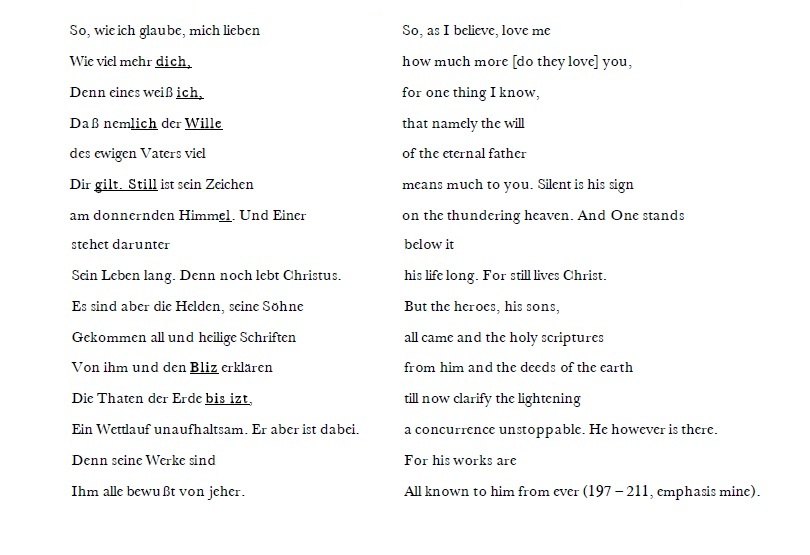Friedrich Hölderlin’s 1802 “Patmos” poetically answers a theological challenge. Dedicated to the Landgraf von Homburg, it responds unsolicited to the count’s call for a poem that might counter contemporary Biblical exegesis, originally addressed to Friedrich Gottlieb Klopstock. [1] And indeed, a poetic refutation could hardly be more appropriate, when it comes to Enlightenment theologians : One of the most scandalous texts of the era, Hermann Samuel Reimarus’ fragment, “Über die Auferstehungeschichte” (“On the Resurrection-Story”), published posthumously by Gotthold Ephraim Lessing, rests its arguments upon poetic logic. Although probability and logical deduction form no small part of his argument, Reimarus’ rhetoric returns again and again to poetic terminology. He calls for the whole resurrection myth to be scrapped, since none of the Evangelists’ accounts are “einstimmig” (one-voiced), nor do they “sich reimen lassen,” (let themselves be rhymed). [2] In fact, looking more closely at the conclusion to Reimarus’ published fragment, poetic principles seem trump the work of reason :
Saget mir vor Gott, Leser, die ihr Gewissen und Ehrlichkeit habt, könnet ihr dies Zeugnis in einer so wichtigen Sache für einstimmig und aufrichtig halten, das sich in Personen, Zeit, Ort, Weise, Absicht, Reden, Geschichten, so mannigfaltig und offenbar wiederspricht ? […]So, daß ich frei sagen mag, es sei fast kein einziger Umstand, von dem Tode Jesu an bis zu Ende der Geschichte,
darin ihre Erzählung zusammen zu reimen wäre . [3]Tell me before God, Readers, you who have conscience and honesty, could you hold this testimony in such an important matter to be coherent (lit : one-voiced, einstimmig) and upright, which in so many ways and so openly contradicts itself in person, time, place, way, intent, speech, and story ? […] So that I might freely say, there is hardly a single circumstance about the death of Jesus up to the end of the story,
where its narrative might be rhymed together ? (emphasis mine).
The ultimate appeal is to the rhyme of a narrative. To be sure, the phrases “sich reimen lassen” and “einstimmig” can work as commonplaces, distanced from the connotations of poetic rhyme and voice. [4] Nonetheless, the rhetoric is significant, for it brings philosophical and theological argument into the sphere of poetics, where rhyme and harmony are the standards.
The implications of this intersection between poetics and theological argument are crucial. The success of either will be contingent upon the standard of measure Reimarus has chosen – rhyme ; the persuasiveness of his arguments, and thus his theology, depends upon correspondence, “rhyme,” “single-voicedness.” But there are other measures. If Reimarus’ poetic logic demands the harmony of rhyme, a counterargument from Klopstock would present the best antidote, indeed. For Klopstock’s oeuvre not only counters Reimarus’ polemical refutation of the resurrection (and this is surely what the Landgraf von Homburg had in mind, when he commissioned the poem) ; it also polemicizes against rhyme. Within his poems, Klopstock will call rhyme a “böse[n] Geist” (evil spirit, ln. 7) and “Wortgepolter” (word-rumbling, ln. 8) : a “Wordpoltergeist.” [5] Against rhyme, in both his poetic compositions and theoretical writings, Klopstock promotes a form of rhymeless metrical organization, whose scansion-units are not abstract stress-patterns, but rather, semantic units called “Wortfüße” (word-feet). [6] The most significant morphemes of these “feet” will, in turn, have the greatest stress and duration, so that the combination of “Wortfüße” in different patterns yield different tempi and “Zeitausdrücke” (time-expressions). [7] To make matters more complicated, these “Wortfüße” are not individual “words” at all, but rather, whole phrases, such as “des Herrn Zorn” “the rage of the god,” which he scans

. [8] Although line– and strophic schemas will repeat, poetic parallelism moves according to different parameters here : not the return of the identical tones, but iterations of paced movements of significance, are to determine poetic sense. Here, the desire not for language to approach “Einstimmung” (agreement, one-voicedness) in sound and thought, but rather, as Winfried Menninghaus has pointed out in his excellent study of Klopstock, for both to approach dance. [9]
This is not the place to enter into the questions of whether a language of accentual prosody such as German could even meet these rules – indeed, many of Klopstock’s “long” syllables are short, accented ones.
[10] Nor is the primary problem whether one poetic measure is better or worse than another – though Klopstock would certainly say so. The point of this brief comparison between Reimarus and Klopstock is that measure is contingent, and that the sense of language may vary radically, depending on the measure involved. All of this at stake, when it comes to considering the sort of poetic thinking that is done by both speakers. All of this is at stake, in approaching the sort of refutation that the Landgraf von Homburg solicits, however little he may have had meter in mind. And yet Klopstock refuses. Hölderlin responds.
But Hölderlin not only abandons regular rhyme as he approaches the theological task “Patmos” performs ; here there are no regular meters to be found, regardless of the scansion system one adopts. No strophe shows precisely the same metrical pattern, the duration of verses range from two (“Nah ist […],” “Near is […],” 1) to nineteen syllables (“Ein Wettlauf unaufhaltsam. Er aber ist dabei. Denn seine Werke sind […]” “A concurrence unstoppable. He however is there. For his works are […]” 210). [11] Nonetheless, I propose to follow the way the poem thinks through meter. If this sounds contradictory, it is because my understanding of “meter” does not rhyme with the modern linguistic one – nor does Hölderlin’s, as this paper will show. Rather, I have in mind the singular measures language takes, from phonetic similarities to syntax, lexis and “metrical” stress patterns – which depend upon the moment and matter of utterance. Such a complexity approaches that of the 5th century Greek μέτρον – which was first of all not confined to the sphere of scansion. And in 1802, ancient Greek and contemporary German measures meet in the singular poetic language of “Patmos.” First I turn to the character of this untimely coincidence and the specific sense of the Greek measure to which I refer.
In the same year he would send “Patmos” to the Landgraf von Homburg, Hölderlin would also send his translations and “Anmerkungen” to Sophocles’ Oedipus Tyrannus and Antigone for publication, after having privately translated thirteen victory odes of Pindar. [12] In the “Anmerkungen” he elevates terms of meter (especially the caesura) to the primary figures of a poetic logic (poëtischer Logik), expanding its field to the whole succession poetry presents of representation and perception and reasoning (Vorstellung und Empfindung und Räsonnement). [13] This gesture, meanwhile, reformulates the expansive sense μέτρον has in the fifth-century BC poetry Hölderlin reads, where it marks an absolutely singular measure at both the subjective and objective levels : Pindar states in the second Pythian ode, χρὴ δὲ κατ’ αὐτὸν αἰεὶ παντὸς ὁρᾶν μέτρον, which Hölderlin translates, “Es ist aber noth, sich selbst gemäs allzeit / Von allem zu sehen das Maas,” “It is however necessary, in measure with oneself always to see the measure of all (63 – 64). [14] The word μέτρον also marks a singular thinking capacity : its stem med* appears as the Greek notion of thinking and devising. [15] The μῆτις of Zeus, Odysseus, and Medea is an intelligence that can flexibly respond to the changing proportions, relations, limits one confronts, measured in the moment one thinks. [16] In this light, if measuring is constant (allzeit), the measures that determine and limit any given relation become radically contingent. Such is the “meter” that drives and changes the language of “Patmos,” as it produces and encounters a manifold of limits.
First of all, “Patmos” – set under the sign of the Greek island where the prophet John would write the Book of Revelations – measures Greek Christian antiquity against its own modern moment, as do Hölderlin’s Sophocles translations and “Anmerkungen.” In both works, Hölderlin defines antiquity and the present in terms of different limits, different metra, as manifested in two singular representational tendencies. Next, I will briefly trace his two articulations of these two tendencies, reading “Patmos” against the “Sophokles-Anmerkungen.” In particular, I will focus on the second and third movements of the tripartite “Patmos,” since it is these moments where the limits that are so important to the “Sophokles-Anmerkungen” appear. After this, I will be able to return to the poem as a whole, having set forth the shifting parameters it undergoes. If the first third traces the speaker’s journey to “Patmos,” the second has to do with precisely the “Auferstehungeschichte” (resurrection story), while the third involves the speaker’s return to his present. Throughout, the “Sophokles-Anmerkungen” will be an important standard of measure for the highly singular limits between which “Patmos” moves, and which it will ultimately elude.
In the “Anmerkungen zur Antigonä,” Hölderlin describes the primary tendency (Haupttendenz) of Greek representations (Vorstellungen) “…
Much later, however, the picture changes for the modern poetic voice of “Patmos.” As the speaker turns from visions of the ancient Greek Christians to his own vision, he states :

[19]
With these words, Hölderlin recalls what he names the “primary tendency in the representations of our time” (die Haupttendenz in den Vorstellungsarten unserer Zeit) in his “Sophokles-Anmerkungen.” That is, “etwas treffen zu können, Geschik zu haben, da das Schicksaallose… unsere Schwäche ist,” “to be able to meet something, to have fate, since the fateless is our weakness.” [20] Without warning, fate intrudes into the poem for the first time, in the speaker’s (modern) time, a time where the “Schicksaallose” (the fateless) is both our weakness and primary tendency. To be sure, the speaker will not meet fate (treffen) ; nor is it a fate that could meet him – he speaks of “Unsterblicher Schicksaal,” or the fate of the immortals. Nonetheless, the poem abruptly veers towards an articulation of fate as the all-powerful force, which governs world and immortals alike. The immortals do not “walten ;” their fate does. For all the obscurities of this passage, one thing is clear : the suddenness and force with which fate appears in Hölderlin’s language belies a “Haupttendenz,” and soon enough, this tendency turns into a hope that fate might move from the sphere of the “Unsterbliche[n]” to us. In the next verses, the speaker calls the modern hope – which is precisely not the Christian one for “Erlösung” (salvation) – a “Loosungszeichen,” or “fate-sign,” which might become the “Stab des Gesangs” (staff of song) (182 – 83).
This movement between two limits, ancient and modern, a gathering and a fate, is presaged in the resonance between “Patmos,” a place-name, and its near-homonym πότμος, fate. These mark spheres of measure as different as cartographical fixity and an absolutely contingent meeting ; as different as the proximity “sich fassen zu können” entails, and the indeterminate distance “Ge-schick” (from schicken, to send out) must traverse. But when the tendencies traced in the “Sophokles-Anmerkungen” specifically emerge in “Patmos ;” when, perhaps tragically, a categorical turn takes place from space towards far-off fate, the poem significantly sets itself in-between, and thus outside, any one measure.
The first and shortest verse of the poem (“Nah ist […]” “Near is […]”) repeats Hölderlin’s translation of the word for “measure” itself, when Oedipus’ first announces Creon’s arrival in Oedipus Tyrannus : ξύμμετρος γὰρ ὡς κλύειν, “for his is within-measure so as to hear,” which Hölderlin translates, “Nah ist er, daß man hört,” “Near is he, so that one hears” (83). “Nah ist :” this is to be ξύμμετρος, within range – within a measurable spatial sphere. But the nearness ceases as the next line of “Patmos” continues, “und schwer zu fassen der Gott,” “and difficult to grasp, the god” (2), placing the god beyond the possibility of the “grasping” (fassen) it names. Something immeasurable, ungraspable intervenes at the moment that measure is evoked in the opening words of “Patmos ;” something that exceeds the measure of nearness. Nonetheless, as nearness returns in the speaker’s language, the “God” transforms – to a space. When the speaker is about to approach the island Patmos, the phonetic figures of the first verses : “

Although a general movement in the poem might be traced from Greek to modern tendencies this movement is already visible in the “journey” of the speaker to “Patmos” at the start of the poem. The nearness of the god coincides with the difficulty of “grasping” (fassen) him, which gives way to a “Geschick” or “fate” in the most literal sense – toward the island of “Patmos” itself. (The words for “fate” in German (Geschick, Schicksal) have everything to do with sending, having been sent (schicken, geschickt worden sein) ; thus it is overdetermined when the fate of the speaker is a journey. He is, to be more exact, “sent” geschickt on his journey, insofar as a “genius” Genius (19) drives him from his home and thus dispatches him elsewhere.) To sum up ; Touching one tendency in words propels the speaker of Patmos in a different direction ; measures shift, as does the very shape of the “Gott,” who reechoes now as the “Grotte.” From the one who might be (with difficulty) grasped, he becomes the place to which one is propelled.
At this point, however, the speaker turns from his narrative of a journey, to a general description of the acoustic space of Patmos – where the “Grotte” might be neared. If the god is no longer mentioned, there is something godly about the way this space supports a gathering and a moment of hearing – a highly specific, poetic gathering of time, space, speech, of measured steps and word.

[21]
The island hears and her children, the “Stimmen des heißen Hains” (the voices of the hot grove, 69) hear as voices. And as these vocal listeners hear (72), an indeterminate echo “es” resounds, intones (72) the laments of the island-guest. But the relation between the listening landscape and the stranger that traverses it is more intricately interwoven than this. The island’s listening process – which includes the catastrophic reshaping she undergoes, as sand falls and surface splits – offers itself to be heard as the effects of the stranger’s steps, as he versifies the sandy earth (in both its literal and figurative senses : plowing and producing song). [22]
Since this marks one moment when poetic measures consummately meet I linger here. Two simple clauses enclose the precondition and realization of the stranger’s arrival : Patmos is “guestfriendly” (gastfreundlich) and ultimately “it resounds from the laments of the man” ([es] tönt wieder von den Klagen des Manns). In between come two complex clauses, one which determines the temporal coordinates of his advent : “And when, lamenting, one nears her” (Und wenn … klagend… ihr nahet einer) ; the other, its spatial coordinates, “And where the sand falls and the field’s surface splits” (Und wo der Sand fällt und sich spaltet / Des Feldes Fläche) – both of which conclude “she hears him” (hört sie es gern) and “they hear him” (sie hören ihn). These clauses align through lexical and grammatical parallelism the 1) hearing the lamenting stranger and hearing 2) the falling sand and splitting surface – as complementary aspects of the same moment. And indeed they are “Gleichzeitig” (of the same time), for metrically, they show the same scansion – which, in the terminology of Hölderlin’s day, means that they have the same “Zeitausdruck” (time-expression). [23] The falling of sand and splitting surface correspond to the stranger’s lamenting approach as its highly precarious, shifting location, which becomes what it is as he nears (and speaks). [24]
I pursue this responsion further. In the passage “Und wo der Sand fällt, und sich spaltet des Feldes Fläche, die Laute, sie hören ihn, und liebend tönt es wieder von den Klagen des Manns” (and where the sand falls and the field’s surface splits, the tones, they hear him, and lovingly it intones/resounds again from the laments of the man), the pronoun “ihn” (him) agrees both with the preposed “Sand” and the postposed “Mann” – which themselves agree in rhyme. The grammatical ambiguity of “ihn,” suspended between two rhyming referents, binds the falling sand and splitting earth and the coming, lamenting man. So inextricably, that only heard together does echo appear “von den Klagen des Mann” (from the laments of the man). For this reason, as a component of the lament – albeit performed by another agent, the land – the falling sand and splitting earth offer themselves to be read with respect to the man’s footsteps. And indeed, it is remarkable that the (metrical) feet of his approach and their opening match, given the irregular rhythms of the whole strophe. One can only grasp it in the speaker’s own words : “Sie hören ihn” (they hear him), the sand beneath the man’s feet, the sound of his voice, as inseparable as the meter and words of a poem – as the space of the island transforms with his nearing. They are ξύμμετρος […] ὡς κλύειν, “Nah […], daß man hört,” “near, so that one hears.” Through modern metrical strategies, an ancient measure is – nearly – met.
Henceforth, however, this poetics of nearness disappears – as though its very articulation were a transgression. Immediately, the poetic narrative departs from its projected, potential arrival upon Patmos, to the youthful travels of the Apostle John and the death of Christ. Lexically, the words “nah” and “nahen” never return – nor is there a place to near. For henceforth all place names disappear, and an opposite tendency emerges : the radically negation of landscape imagery, so crucial to the first strophes and to the possibility for a culminating nearness upon Patmos.
I turn to the culminating moment of this negation – of nearness, of space – which comes after the twice-told departure of Christ from the world. It comes, in fact, in the strophe that structurally answers the one I have dwelt upon, within the larger measures of the poem. If “Patmos” was approached in the fifth strophe, space is completely ravaged in the tenth of this fifteen-strophe ode, marking its middle third. [25]

Here, an indeterminate “es” becomes the subject of a radical destruction : “und nicht den Sand nur oder / Die Weiden es hinwegnimmt und die Tempel / Ergreifft,” (and it takes away not only the sand or the pastures and seizes the temples). By the end, all that remains is the original difference between heaven and earth, reminiscent of Genesis, “daß nirgend ein / Unsterbliches mehr
As limits transform beyond recognition, after the possibility of nearness, “sich fassen zu können,” is fully negated, the poem posits a new μέτρον, affirming the modern measure of fate – “es waltet aber Unsterblicher Schicksaal” (it-rules however the fate of the immortals)– which is followed by the anticipation and arrival of a “Loosungszeichen” (fate-sign), as though fate were met with its sign’s invocation. Insofar as it is “niederwinkend” (signaling-downward) this “Loosungszeichen” also seems to arrive as πότμος, which comes from πίπτειν, to fall. [26] Nonetheless, this is no meeting that belongs to our time and conditions. Broken over a double enjambment between strophes, this staff or “Loosungszeichen” moves only from the heavens to the dead. Of it the speaker says : “Die Todten weket / Er auf, die noch gefangen nicht/ Vom Rohen sind” (It awakens the dead, who are not yet imprisoned by the raw / unripe). [27] An otherworldly message meets an otherworldly destination more foreign than Greece.
The modern hope – at least as “Patmos” presents it – is beyond our time, and in order to retreat from this apocalyptic moment, the poem resorts to a new – old – measure : rhyme : [28]
But this strategy quickly explodes, as one rhyme-pair brings together “Bliz” (lightening) and “izt” (now). From here breaks forth a verse of nineteen syllables, the longest of the poem. Far from containing the poetic matter, the measure of rhyme produces a new rupture. When the next and final strophe suddenly breaks off anew, “Zu lang, zu lang schon ist[…],” (too long, too long already is, ln. 212) it first seems to refer to this – and to rue the poem’s latest transgression. From here, the poem closes with a revision of the “Loosungszeichen,” (fate-sign) “der Stab des Gesangs” (staf of song), with its famous last lines : “Unwissend, der Vater aber liebt, / Der über allen waltet / Am meisten, daß gepfleget werde / Der veste Buchstab, und bestehendes gut / Gedeutet. Dem folgt deutscher Gesang” (Unknowingly, the father however, who prevails over all, loves most that the solid letter shall be tended and withstandingly well interpreted. German song follows it, 222 – 226). In place of a meeting, the poem anticipates a pursuit, a following of the “Buchstab,” (letter) – with no end in sight. We are far from the nearness of “Patmos,” the reach of fate and the reassurance of rhyme. Instead, the poem and its “we” are simply left… far. Left to μήδεσθαι, to think, to devise – perhaps to answer unsolicited the call that resounds in the measureless caesura of Hölderlin’s closing line.






